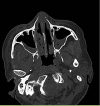Co-Infection of Mucormycosis and COVID-19: A Retrospective Cross-Sectional Study of Patients Admitted to Imam Khomeini Hospital in Ahvaz, Iran
- PMID: 40391268
- PMCID: PMC12086647
- DOI: 10.1002/hsr2.70831
Co-Infection of Mucormycosis and COVID-19: A Retrospective Cross-Sectional Study of Patients Admitted to Imam Khomeini Hospital in Ahvaz, Iran
Abstract
Background and aims: During the COVID-19 pandemic, the emergence of mucormycosis, a rare but often fatal fungal infection, gained significant attention due to its increased prevalence among immunocompromised patients. This study aimed to determine the prevalence and characterize the clinical features of COVID-19-associated mucormycosis in patients admitted to Imam Khomeini Hospital, Ahvaz, Iran.
Methods: This retrospective, cross-sectional study analyzed clinical data from patients admitted between November 2020 and November 2021. Inclusion criteria encompassed individuals with concurrent diagnoses of COVID-19 and mucormycosis. Data collected included demographic details, clinical features, comorbidities, laboratory findings, and treatment information. Descriptive statistics were used to summarize patient characteristics, and prevalence estimates were provided with 95% confidence intervals.
Results: Of the 12,978 hospitalized patients during the study period, 31 individuals (0.2%, 95% CI: 0.2%-0.3%) were diagnosed with COVID-19-associated mucormycosis. The prevalence was highest among male patients (54.8%) and those aged 60 years or older (48.4%). Diabetes was the most prevalent comorbidity, and the most frequent clinical symptoms included respiratory distress and cough. Patients with severe COVID-19 exhibited a significantly higher prevalence of co-infection, suggesting a greater vulnerability in this subgroup.
Conclusion: COVID-19-associated mucormycosis primarily affects elderly male patients with underlying diabetes and severe COVID-19 illness. These findings underscore the importance of early detection and intervention, particularly for high-risk individuals. Further research is warranted to optimize prevention and management strategies for this serious complication.
Keywords: COVID‐19 virus disease; Mucormycosis; co‐infection; fungal infections.
© 2025 The Author(s). Health Science Reports published by Wiley Periodicals LLC.
Conflict of interest statement
The authors declare no conflicts of interest.
Figures



Similar articles
-
Increased incidence of rhino-orbital mucormycosis in an educational therapeutic hospital during the COVID-19 pandemic in western Iran: An observational study.Mycoses. 2021 Nov;64(11):1366-1377. doi: 10.1111/myc.13351. Epub 2021 Jul 31. Mycoses. 2021. PMID: 34252988 Free PMC article.
-
Mucormycosis in pre-COVID-19 and COVID-19 era: A study of prevalence, risk factors and clinical features.Laryngoscope Investig Otolaryngol. 2022 Sep 7;7(5):1343-50. doi: 10.1002/lio2.899. Online ahead of print. Laryngoscope Investig Otolaryngol. 2022. PMID: 36249085 Free PMC article.
-
Long-term Outcome of Coronavirus Disease-associated Mucormycosis: 1-year Follow-up Study from India.J Assoc Physicians India. 2024 Jun;72(6):44-48. doi: 10.59556/japi.72.0564. J Assoc Physicians India. 2024. PMID: 38881134
-
COVID-19 associated mucormycosis - An emerging threat.J Microbiol Immunol Infect. 2022 Apr;55(2):183-190. doi: 10.1016/j.jmii.2021.12.007. Epub 2022 Jan 13. J Microbiol Immunol Infect. 2022. PMID: 35074291 Free PMC article. Review.
-
Mixed Aspergillosis and Mucormycosis Infections in Patients with COVID-19: Case Series and Literature Review.Mycopathologia. 2024 Jan 17;189(1):10. doi: 10.1007/s11046-023-00808-z. Mycopathologia. 2024. PMID: 38231407 Review.
References
-
- World Health Organization , “WHO Coronavirus (COVID‐19) Dashboard,” published 2023, https://covid19.who.int/.
-
- Wu Z. and McGoogan J. M., “Characteristics of and Important Lessons From the Coronavirus Disease 2019 (COVID‐19) Outbreak in China: Summary of a Report of 72 314 Cases From the Chinese Center for Disease Control and Prevention,” Journal of the American Medical Association 323, no. 13 (2020): 1239–1242. - PubMed
-
- Patel A., Kaur H., Xess I., et al., “A Multicentre Observational Study on the Epidemiology, Risk Factors, Management and Outcomes of Mucormycosis in India,” Clinical Microbiology and Infection 26, no. 7 (2020): 944.e9–944.e15. - PubMed
LinkOut - more resources
Full Text Sources

